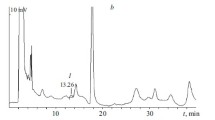Summary
The metabolism of a new piracetam analogue, the dipeptide cognitive enhancer N-phenylacetyl-l-prolylglycine ethyl ester (GVS-111) was studied in vivo. GVS-111 itself was not found in rat brain 1 h after 5 mg/kg i.p. administration up to limit of detection (LOD) under high performance liquid chromatography (HPLC) conditions. Three substances corresponding to the three possible GVS-111 metabolites, namely phenylacetic acid, prolylglycine and cyclo-prolylglycine, were found in experimental rat brain samples as well as in controls using HPLC, gas chromatography (GC) and gas chromatography-mass spectrometry (GC-MS) methods. Only cyclo-prolylglycine concentration increased (2.5-fold) 1 h after GVS-111 administration. Cyclo-prolylglycine formation from GVS-111 in the presence of plasma and brain enzymes was shown in vitro. These data could be considered as evidence that GVS-111 is prodrug which converts in the body to cyclo-prolylglycine, and which is identical to the endogenous cyclopeptide that produces the nootropic activity.
Similar content being viewed by others
References
Gudasheva T.A., Voronina T.A., Ostrovskaya R.U., et al. (1996): Synthesis and antiamnesic activity of a series of N-acylprolyl-containing dipeptides. Eur. J. Med. Chem., 31, 151–157.
Seredenin S.B., Voronina T.A., Gudasheva T.A., et al. (1995): Biologically active N-acylprolyldipeptides having antiamnestic, antihypoxic and anorexigenic effects. US Patent 5,439,930.
Ostrovskaya R.U., Gudasheva T.A., Trofimov S.S., et al. (1995): In: Seredenin S.B., Longo V., Gaviraghi G., eds. Biological Basis of Individual Sensitivity to Psychotropic Drugs. Edinburgh: Graffmann, 80–91.
Ostrovskaya R.U., Trofimov S.S., Gudasheva T.A., et al. (1996): GVS-111, Novel cognition enhancer of dipeptide structure. In: Book of Abstracts: 24th European Peptide Symposium, Edinburgh, Scotland, 7.
Gudasheva T.A., Boyko S.S., Akparov V.K., et al. (1996): Identification of the novel endogenous memory facilitating cyclic dipeptide cyclo-prolylglycine in rat brain. FEBS Lett., 391, 149–151.
Smith E.L., Bergmann M. (1944): Peptidases of intestinal mucosa. J. Biol. Chem., 153, 627–631.
Rydon H.N., Smith P.W.G. (1956): Polypeptides. Part IV. The self-condensation of esters of some peptides of glycine and proline. J. Am. Chem. Soc., 78, 3644–3646.
Pinnen F., Zanotti G., Lucente G. (1982): Cyclol formation from tripeptides containing β-alanine. J. Chem. Soc., Perkin Trans I, 1311–1316.
Dourish C.T., Davis B.A., Dyck L.E., Jones R.S.G., Boulton A.A. (1982): Alteration in trace amino and trace acid concentration in isolated aggressive mice. Pharmacol. Biochem. Behav., 17, 1291–1294.
Van der Greef J., Tas A.C., Nijssen L.M., Jetten J. (1987): Identification and quantitation of diketopiperazines by liquid chromatography-mass spectrometry, using a moving belt interface. J. Chromatogr., 394, 77–88.
Author information
Authors and Affiliations
Rights and permissions
About this article
Cite this article
Gudasheva, T.A., Boyko, S.S., Ostrovskaya, R.U. et al. The major metabolite of dipeptide piracetam analogue GVS-111 in rat brain and its similarity to endogenous neuropeptide cyclo-l-prolylglycine. European Journal of Drug Metabolism and Pharmacokinetics 22, 245–252 (1997). https://doi.org/10.1007/BF03189814
Received:
Issue Date:
DOI: https://doi.org/10.1007/BF03189814




